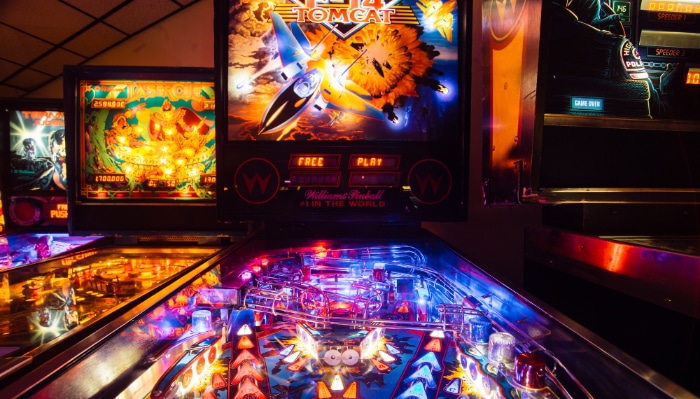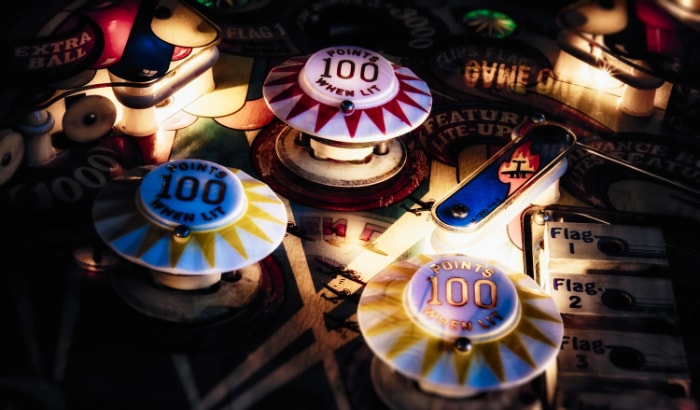Why Are Pinball Machines So Expensive? Unveiled

Capturing both nostalgia and modern technological marvels, pinball machines remain an enduring symbol of arcade culture and entertainment. While many might be enamored by the flashing lights, intricate mechanics, and the adrenaline-pumping challenge of keeping a steel ball in play, they often find themselves taken aback by the price tag that comes with these captivating devices.
Why are pinball machines so expensive? Is it a reflection of their complexity, the quality of materials used, or other less obvious factors?
The Complexity of the Mechanical Design
A pinball machine is far more than a box filled with flashing lights and bouncing balls; it's an engineering marvel. The complexity involved in creating a machine that is both fun to play and reliable is often underestimated.
Mechanical Components That Make Up a Pinball Machine
A standard pinball machine houses a range of mechanical components, from flippers and bumpers to ramps and drop targets. Each component must be designed to exact specifications to ensure smooth gameplay and long-lasting durability.
The integration of these mechanical elements in a confined space is itself a significant engineering feat.
Challenges in Mechanical Design
Creating a pinball machine poses various challenges, such as harmonizing multiple moving parts, ensuring efficient ball flow, and incorporating advanced features like multi-ball play or magnetic fields. The design process often requires multiple iterations and refinements, ramping up costs in terms of both time and labor.
Labor and Expertise
Designing a pinball machine isn't a job for a lone wolf; it requires a team of skilled professionals, including mechanical engineers, industrial designers, and other specialized roles. Each team member must have a high level of expertise to contribute to the machine's complex design, and this specialized labor comes at a price.
Prototyping and Validation
Before a pinball machine hits the market, it must go through a rigorous prototyping stage. Manufacturers create prototype machines that are then tested extensively to validate the mechanical design.
This process is both time-consuming and costly, as it often requires the production and assembly of custom parts.
Longevity and Reliability
When you're dropping a substantial amount of money on a pinball machine, you expect it to last. The complex mechanical design must not only provide an engaging experience but also stand up to repeated use over a prolonged period.
Achieving this level of durability necessitates the use of high-quality components and meticulous assembly, further adding to the overall cost.
High-Quality Materials
The allure of a pinball machine isn't solely based on its gameplay or visual appeal. An essential aspect that often goes unnoticed is the quality of materials used in its construction.
These materials contribute significantly to the durability, performance, and, ultimately, the cost of the machine.
Types of Materials Used
From the metal ball bearings to the glass playfield cover and the plastic ramps, a pinball machine is a composite of various materials. Metals are commonly used for their durability and ability to withstand mechanical stress.
Plastics are favored for their versatility and lower weight, and glass is often chosen for its clarity and scratch-resistant properties.
Importance of Durability
Given the mechanical stress that pinball machines endure, durability is a prime consideration. A machine might undergo thousands of games over its lifetime, and low-quality materials would simply not hold up.
The focus on durability inherently drives the selection towards higher-quality, and often more expensive, materials.
Material Sourcing and Availability
The quality of materials is directly related to their source. Manufacturers opt for suppliers that provide certified and reliable materials, adding another layer to the machine's cost.
Moreover, certain high-quality materials might be scarce or expensive to procure, contributing to a higher manufacturing expense.
Assembly and Labor
High-quality materials can be challenging to work with. Metals may need to be precisely machined, plastics may require specialized molds, and glass must be cut and treated with care.
All these steps demand skilled labor, specialized tools, and sometimes even custom machinery, adding to the overall cost of the machine.
Eco-Friendly Considerations
In an age where sustainability is a growing concern, some manufacturers opt for eco-friendly materials. These materials, while beneficial for the environment, often come with a higher upfront cost, adding yet another dimension to the overall pricing structure of a pinball machine.
Intellectual Property and Licensing

Many pinball machines captivate players through themes that feature well-known characters, movies, or bands. While these themes add to the machine's appeal, they also often involve intellectual property and licensing agreements that can substantially elevate the cost.
The Allure of Branded Themes
Themes based on popular culture often attract a broader audience. These might range from blockbuster movie franchises to classic rock bands.
Integrating such themes into a pinball machine necessitates an agreement between the machine manufacturer and the intellectual property holder, which can be a costly affair.
Licensing Fees and Cost Structure
The use of copyrighted material is not free. Manufacturers must pay licensing fees to the intellectual property owners.
These fees can be significant and are generally calculated based on anticipated sales volumes, sometimes even including ongoing royalties based on actual sales. This invariably becomes a part of the machine's final retail price.
Legal Processes and Negotiations
Securing rights to a brand or theme often involves intricate legal processes. Contracts must be negotiated, terms have to be agreed upon, and lawyers need to review all details.
These legal steps not only take time but also involve expenses, further adding to the cost of the pinball machine.
Design Adaptation and Approval
Once the licensing agreement is in place, the pinball machine's design must integrate the intellectual property in a way that meets the licensor’s standards. This often requires multiple iterations and approvals, leading to an extended development cycle that can add to the project's cost.
Market Exclusivity
The use of licensed themes often grants a degree of market exclusivity to the pinball machine, creating a unique selling point. However, exclusivity agreements can also drive up the licensing fees, as the intellectual property holder may charge a premium for such an arrangement.
Manufacturing and Labor Costs
The manufacturing process of a pinball machine is far from simple assembly. It's a labor-intensive endeavor involving multiple stages, each with its own set of costs.
Manufacturing Complexity and Time
Producing a pinball machine is not a straightforward task. Each unit comprises hundreds, sometimes thousands, of individual parts that must be precisely assembled. This complexity requires an extended manufacturing time, directly correlating to higher labor costs.
Skilled Labor Requirement
The assembly of a pinball machine is not something that can be fully automated; it often requires skilled labor. Workers must possess specialized knowledge to assemble the complex mechanical and electronic components properly.
The cost of skilled labor is considerably higher than unskilled labor, contributing to the overall expense.
Quality Control Measures
Quality is paramount in pinball machine manufacturing. Each unit must go through rigorous quality control checks to ensure its functionality and durability.
These quality checks are time-consuming and require skilled technicians, thus incurring additional costs.
Custom and Specialized Parts
Many components in a pinball machine are not off-the-shelf but custom-made. Custom parts are typically more expensive due to the specialized manufacturing processes they require.
Even seemingly simple parts like screws and bolts may be custom-engineered for a specific machine, adding to the cost.
Economies of Scale
Unlike mass-produced items, pinball machines are often manufactured in limited quantities. The lower production volume means that economies of scale are not fully realized, making each unit more expensive to produce.
Software and Electronics
While the mechanical aspects of a pinball machine often draw the most attention, the role of software and electronics is equally vital. These components are the brains behind the operation, controlling everything from scoring and game logic to lighting and sound effects.
Embedded Systems and Microcontrollers
Modern pinball machines are equipped with embedded systems and microcontrollers that manage the machine's various functions. These components are not just standard chips but are often custom-designed to meet the unique requirements of each machine, making them more expensive than generic alternatives.
Software Development and Programming
Creating the software that controls a pinball machine is a labor-intensive process. Developers must write code to control numerous aspects of gameplay, lighting patterns, and sound effects.
This requires specialized knowledge and results in additional development costs that are ultimately passed on to the consumer.
Advanced Features and Interactivity
Recent pinball machines incorporate advanced features like interactive LCD displays, complex game modes, and connectivity options. These features require more sophisticated electronics and software, driving up the costs even further.
Testing and Debugging
Just like the mechanical components, the software and electronics require extensive testing to ensure reliability and durability. Debugging software and making sure all electronic components function as intended is a critical and time-consuming step that adds to the production cost.
Firmware Updates and Support
Post-launch, many modern pinball machines receive firmware updates to fix bugs, add new features, or enhance existing ones. The cost of developing and distributing these updates is also a factor that contributes to the overall expense of the machine.
Operating and Distribution Costs
While the production aspects of a pinball machine account for a significant portion of its price, one cannot overlook the role of operating and distribution costs. These are the expenses incurred in getting the machine from the factory floor to the customer's location.
Warehousing and Inventory
Holding stock requires space, and space costs money. Warehousing involves not just the rent of the physical space but also utilities and staffing needs. For products as large and heavy as pinball machines, these costs can be substantial and directly impact the retail price.
Shipping and Logistics
Transporting a pinball machine is no small feat. These machines are bulky and sensitive, requiring special handling during shipping. Specialized logistics services are often used to ensure the machines arrive in mint condition, which adds to the overall expense.
Import and Export Taxes
If a pinball machine is produced in one country and sold in another, import and export taxes can significantly increase the price. These taxes vary by country and can depend on various factors like the material composition of the machine and trade agreements between countries.
Retail Markup
Retailers also need to make a profit and cover their operating costs. This adds another layer to the price structure.
While direct sales from manufacturers to consumers can sometimes reduce this markup, even then, the manufacturer must cover their own sales and marketing expenses.
After-Sales Support and Warranty
Customers expect some level of after-sales support and usually a warranty, both of which represent ongoing costs. Whether it's offering free parts for repairs or maintaining a customer service hotline, these services incur expenses that are factored into the product’s retail price.
Conclusion
Pinball machines captivate enthusiasts and newcomers alike with their intricate design, compelling themes, and engaging gameplay. However, their allure comes with a hefty price tag, which can often be surprising to those unfamiliar with what goes into creating these complex machines.
The contributing factors to the cost are multifaceted, ranging from the intricacies of mechanical design and the high-quality materials used, to intellectual property licensing and the specialized labor involved. Additional layers of expense come from the complex software and electronics that bring the machine to life, as well as the operating and distribution costs necessary to get the machine into the hands of consumers.
Collectively, these elements paint a comprehensive picture of why pinball machines are such costly investments. While the expense may be significant, the cost is a reflection of the numerous components, human effort, and intellectual property that come together to create a single unit of this beloved form of entertainment.


